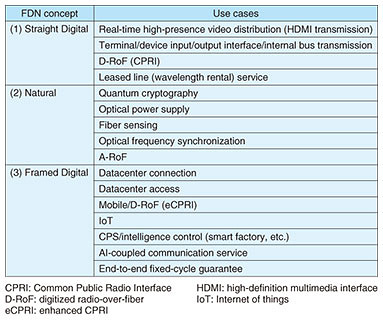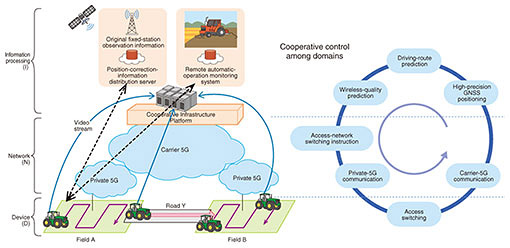 |
|||||||||||||||
|
|
|||||||||||||||
|
Feature Articles: Network-service Technologies Enabled by the All-Photonics Network for IOWN Vol. 19, No. 10, pp. 18–24, Oct. 2021. https://doi.org/10.53829/ntr202110fa1 Network-service Technology Enabled by the All-Photonics NetworkAbstractTo implement the Innovative Optical and Wireless Network (IOWN), an advanced network that can efficiently process a large amount of data incomparable with the conventional Internet is required. To satisfy this requirement, NTT is researching and developing the epoch-making All-Photonics Network (APN), which will make maximum use of photonics-electronics convergence technology. This article describes activities related to function-dedicated network (FDN) architecture and the network-service technology that can be implemented on an FDN to provide various services via the APN. Keywords: IOWN, APN, network architecture 1. All-Photonics NetworkThe goal with the All-Photonics Network (APN) [1], which is one element of the Innovative Optical and Wireless Network (IOWN) [2], is to have it become the infrastructure of infrastructure of various information and communication technology (ICT) platforms in the digital-transformation and digital-distribution era. To meet this goal, we aim to build a network that enables anyone to (i) use ultra-high-speed optical transmission and wireless transmission by connecting not only communication buildings but also user facilities (factories, hospitals, etc.) and datacenters with wideband optical networks and wireless access in an end-to-end (E2E) manner and (ii) share such a network (as an infrastructure of infrastructure) with services provided as an ICT infrastructure for various industries. Various services that will be possible with the APN are illustrated in Fig. 1.
As shown in Fig. 1, the APN will be an infrastructure that (i) provides a large-capacity, low-delay optical multicast path on demand on an arbitrary ground-to-ground basis to provide video distributors and users with high-presence video-distribution services such as 4K and 8K; (ii) provides a closed feedback path that guarantees mission-critical remote-control message forwarding from multi-access edge computing located near the user to terminals via wireless access; and (iii) supports mission-critical remote-monitoring-and-control services in various usage scenarios such as autonomous vehicles and factory-control systems. Serving as an infrastructure platform for various ICT and networks, the APN will also provide optical transmission services between large-scale datacenters and among base stations, wireless control systems, and the mobile core for fifth-generation mobile communication systems (5G) and 6G. 2. Function-dedicated networksTo provide services with various network requirements and enable them to coexist in the same network (i.e., the APN), a function-dedicated network (FDN) architecture [3] is adopted. FDN types and examples of use cases are shown in Table 1.
An FDN provides three types of transmission services: (1) digital signal transmission (Straight Digital), which maps digital signals directly to the optical path; (2) analog signal transmission (Natural), which maps analog signals directly to the optical path; and (3) packet frame transmission (Framed Digital), which frames data into packets and transfers the framed data to the optical path. Types (1) and (2) are the characteristic services that will be provided via the APN. An example of (1) is a service that transmits high-definition-media-interface and other signals for low-latency video transmission over an optical path. An example of (2) is a cryptographic-key transmission service using quantum cryptography for ultra-secure communication. For (3), an FDN is characterized by its ability to provide E2E defined-period-guaranteed services for frequency-synchronized transmission of control messages in an E2E manner using the ultra-high capacity of optical fiber. A model of the architecture to create such an FDN is shown in Fig. 2. The FDN combines APN transmission and a wireless infrastructure, a data-centric infrastructure (DCI), namely, the compute infrastructure, and network functions for controlling connections between terminals and data distribution. As shown in Fig. 2, following the instructions of the multi-orchestrator, the FDN controller provides dedicated E2E forwarding functions to meet various service requirements by controlling the configuration and allocating respective resources to coordinate between domains, namely, the APN, wireless infrastructure, DCI, and network functions.
3. On-demand photonic multipoint connection technology to support high-presence communication servicesMeetings and events that used to be commonplace where many people would gather in one place and share the space are now being held remotely from a variety of locations, and while people find this state of affairs convenient, they expect more-realistic communication and high-definition visuals. These drawbacks are due to the limitations of the network technology that supports the services that can be used by a large number of people. Such services will be transformed into high-presence communication services through the creation and popularization of new network technology. To develop this new network technology, we are actively researching on-demand photonic multipoint connection technology (Photonics On-demand) as one element of an FDN [4]. To actualize Photonics On-demand, the APN must create a much larger number of optical communication connections in the same network than possible with current technologies. Therefore, two problems arise: (i) a conventional leased-line service incurs a large cost burden on the user because the optical path is left unattended and (ii) it takes time to start using the service because it requires time to design and set up the optical path. Accordingly, automatic-configuration control software is introduced to the FDN as a control mechanism to mediate between the user and APN; as a result, the user will be provided with an optical-communication path with the desired quality when they want it. This mechanism makes it possible to provide an inexpensive, low-latency, broadband optical path for video events in the Remote World. Moreover, the optical connections for each event (with different requirements) can be provided without interfering with each other; therefore, many events can be provided simultaneously in a manner that reduces service costs. Although this technology is in the realm of optical networks, it can also contribute to the provision of high-presence services to wireless users by combining and coordinating with the next-generation wireless control technology described below (Fig. 3).
4. Extreme network as a serviceTo cover a variety of use cases involving an FDN, it is necessary to provide services including wireless access. To extend the scope of an FDN to wireless access, we are researching and developing a network service called extreme network as a service (NaaS), which can continuously satisfy extreme requirements (such as ultra-low latency, ultra-reliability, and ultra-high capacity) in an E2E manner by using various access methods (Fig. 4).
Three types of innovation are pursued with extreme NaaS. The first innovation is to change from providing user-specified access to providing an access environment that enables users to do what they want. It would thus become possible for users to use the services they want without being aware of the various access methods. The second innovation is to expand control information. By using various types of information (such as sensor information from cameras and human behavior) as control signals, we aim to create highly accurate predictions and new added value. The third innovation is expanding access itself. That means expanding access to extreme service areas such as outer space and undersea and maximizing the potential of wireless space. To make extreme NaaS a reality, various wireless technologies and their peripheral technologies must be upgraded and combined. Two technologies that play an important role in meeting this need are Multi-radio Proactive Control Technologies (Cradio®) [5] and beamforming technology using analog radio-over-fiber (RoF) [6]. Cradio combines various wireless technologies (such as wireless sensing and visualization, wireless-quality prediction and estimation, and wireless-network dynamic design and control) in multiple wireless networks, including private and public networks, to meet ever-changing user requirements and radiowave conditions. By cooperating with various social systems and applications, Cradio also makes it possible to create a natural communication environment in which people do not need to be aware of the wireless networks. Regarding beamforming technology using analog RoF, a wireless analog signal is transmitted directly on a fiber without digital conversion in a manner that makes it possible to reduce the size and cost of antennas that are deployed in many areas. Remote beamforming also enables efficient area deployment of antennas. 5. Services provided by the Cooperative Infrastructure PlatformTo provide services, such as agricultural ICT and mobility as a service (MaaS), by using the APN, it is necessary to satisfy service requirements in an E2E manner by linking terminals, cloud infrastructure, and networks. The architecture of the Cooperative Infrastructure Platform [7], which is an important elemental technology of an FDN and is being researched and developed to enable this cooperation, is explained below. An example of the cooperative operation on the Cooperative Infrastructure Platform in the agricultural ICT field is shown in Fig. 5. In this example, farm work is automated by implementing remote monitoring and control for operating farm machinery within and between fields. When a tractor moves from field A to field B, the mobile network is switched from private 5G to carrier 5G, and the tractor and Cooperative Infrastructure Platform proactively predict the tractor’s movement and position and communication quality for the field in question and switch to the optimal mobile network before the communication quality deteriorates.
In this example, the remote-control and monitoring functions on the cloud infrastructure use Global Navigation Satellite System (GNSS) positioning to determine the current position and predict the future route and wireless quality. When the quality of private 5G is predicted to degrade, an instruction is executed to switch to a carrier-5G network before such degradation occurs. Such a mechanism enables switching in an E2E manner without communication breakdown from the application layer. It will thus enable remote monitoring and control of mission-critical services such as level-3 automated driving of agricultural machinery, i.e., monitoring and controlling the machinery from locations far from the field such as monitoring centers. 6. Future developmentsTypical network services enabled by the APN and an FDN were described, and examples of their implementation were presented. To promote system implementation and social implementation of the APN, we will continue to study architectures that enable these network services as well as conducting proofs of concept for each use case. References
|
|||||||||||||||








